Icon College BTEC HND in Business Unit 5 Management Accounting Report
VerifiedAdded on 2023/01/16
|21
|5817
|92
Report
AI Summary
This report on management accounting covers key concepts and systems. It begins with an introduction to management accounting, explaining its role in organizational decision-making, and then dives into different types of management accounting systems such as cost accounting, inventory management, price optimization, and job costing. The report then explores various methods for reporting in management accounting, including budget reports, performance reports, and cost reports, highlighting their importance for internal stakeholders. Furthermore, the assignment examines the advantages and disadvantages of different planning tools used in budgetary control. Finally, the report provides a comparison of how different organizations adapt managerial accounting systems to address financial problems, providing a holistic view of the subject matter.
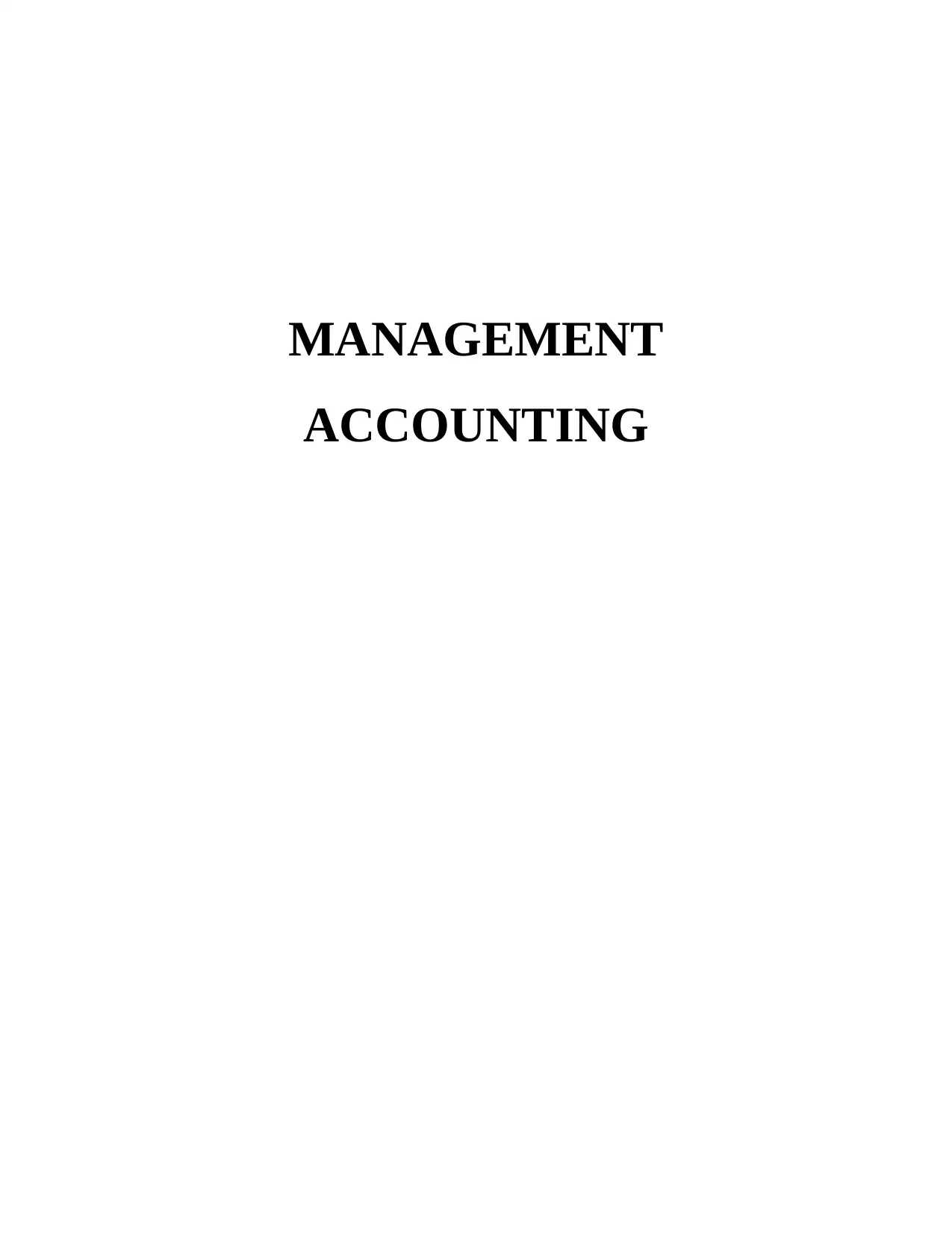
MANAGEMENT
ACCOUNTING
ACCOUNTING
Paraphrase This Document
Need a fresh take? Get an instant paraphrase of this document with our AI Paraphraser
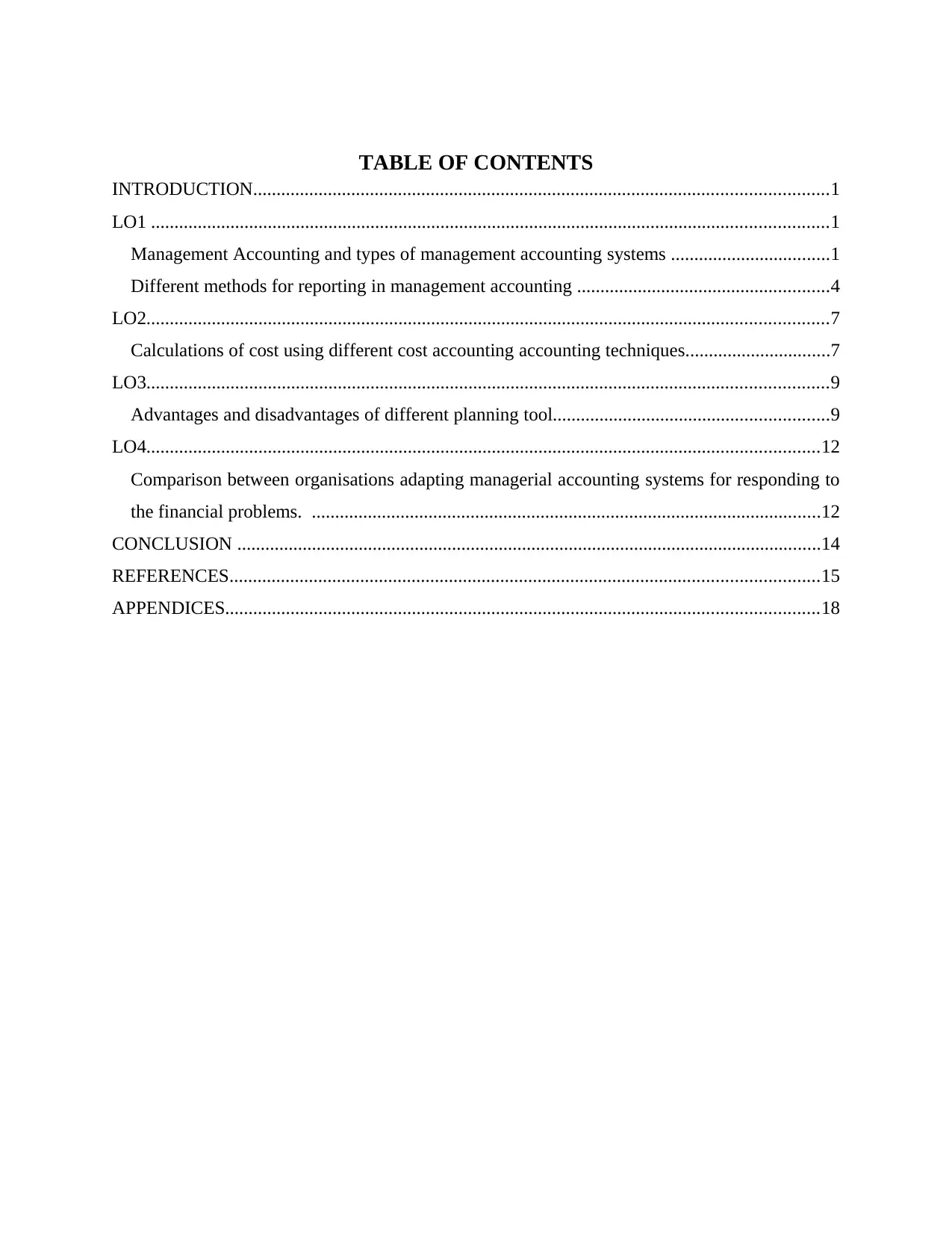
TABLE OF CONTENTS
INTRODUCTION...........................................................................................................................1
LO1 .................................................................................................................................................1
Management Accounting and types of management accounting systems ..................................1
Different methods for reporting in management accounting ......................................................4
LO2..................................................................................................................................................7
Calculations of cost using different cost accounting accounting techniques...............................7
LO3..................................................................................................................................................9
Advantages and disadvantages of different planning tool...........................................................9
LO4................................................................................................................................................12
Comparison between organisations adapting managerial accounting systems for responding to
the financial problems. .............................................................................................................12
CONCLUSION .............................................................................................................................14
REFERENCES..............................................................................................................................15
APPENDICES...............................................................................................................................18
INTRODUCTION...........................................................................................................................1
LO1 .................................................................................................................................................1
Management Accounting and types of management accounting systems ..................................1
Different methods for reporting in management accounting ......................................................4
LO2..................................................................................................................................................7
Calculations of cost using different cost accounting accounting techniques...............................7
LO3..................................................................................................................................................9
Advantages and disadvantages of different planning tool...........................................................9
LO4................................................................................................................................................12
Comparison between organisations adapting managerial accounting systems for responding to
the financial problems. .............................................................................................................12
CONCLUSION .............................................................................................................................14
REFERENCES..............................................................................................................................15
APPENDICES...............................................................................................................................18
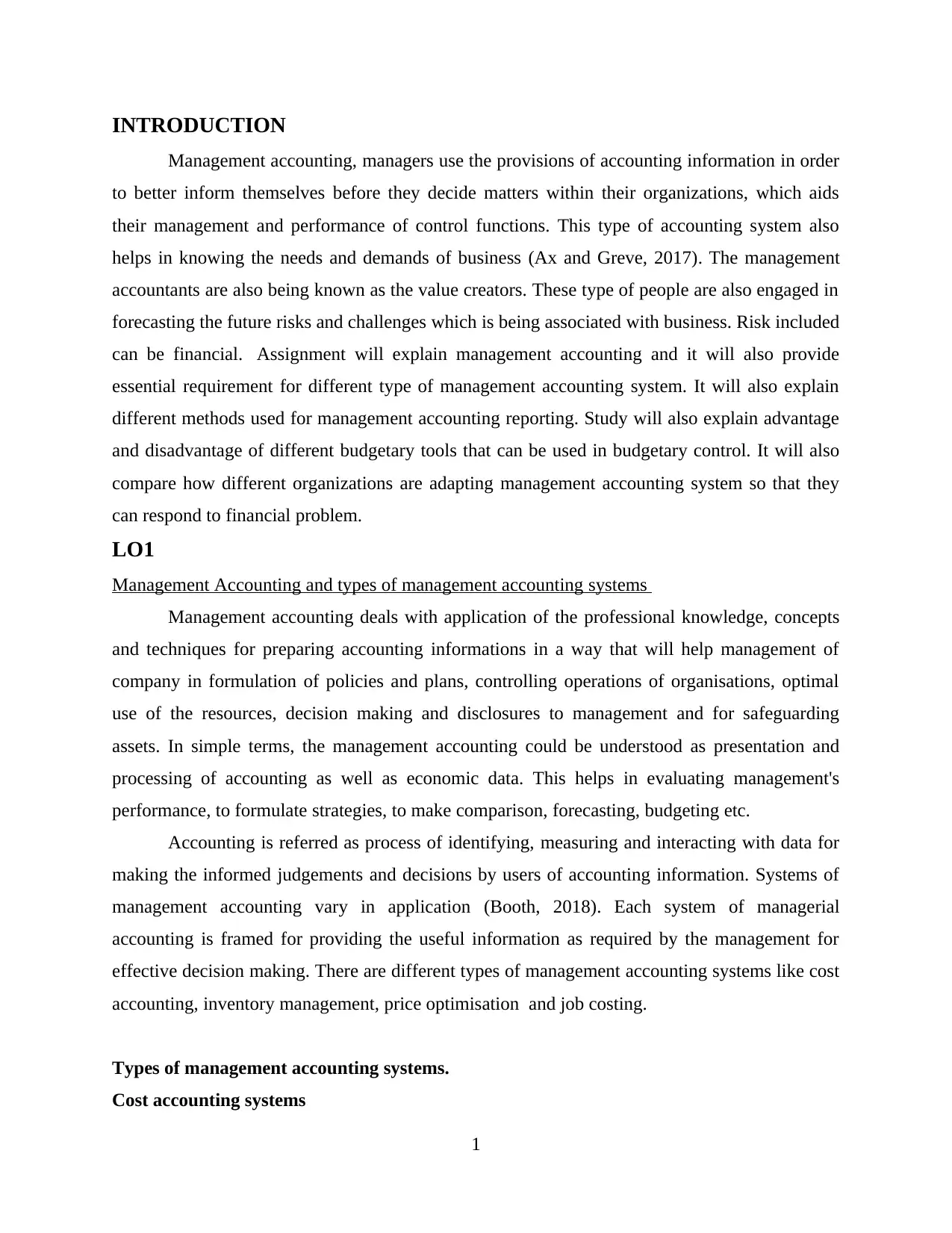
INTRODUCTION
Management accounting, managers use the provisions of accounting information in order
to better inform themselves before they decide matters within their organizations, which aids
their management and performance of control functions. This type of accounting system also
helps in knowing the needs and demands of business (Ax and Greve, 2017). The management
accountants are also being known as the value creators. These type of people are also engaged in
forecasting the future risks and challenges which is being associated with business. Risk included
can be financial. Assignment will explain management accounting and it will also provide
essential requirement for different type of management accounting system. It will also explain
different methods used for management accounting reporting. Study will also explain advantage
and disadvantage of different budgetary tools that can be used in budgetary control. It will also
compare how different organizations are adapting management accounting system so that they
can respond to financial problem.
LO1
Management Accounting and types of management accounting systems
Management accounting deals with application of the professional knowledge, concepts
and techniques for preparing accounting informations in a way that will help management of
company in formulation of policies and plans, controlling operations of organisations, optimal
use of the resources, decision making and disclosures to management and for safeguarding
assets. In simple terms, the management accounting could be understood as presentation and
processing of accounting as well as economic data. This helps in evaluating management's
performance, to formulate strategies, to make comparison, forecasting, budgeting etc.
Accounting is referred as process of identifying, measuring and interacting with data for
making the informed judgements and decisions by users of accounting information. Systems of
management accounting vary in application (Booth, 2018). Each system of managerial
accounting is framed for providing the useful information as required by the management for
effective decision making. There are different types of management accounting systems like cost
accounting, inventory management, price optimisation and job costing.
Types of management accounting systems.
Cost accounting systems
1
Management accounting, managers use the provisions of accounting information in order
to better inform themselves before they decide matters within their organizations, which aids
their management and performance of control functions. This type of accounting system also
helps in knowing the needs and demands of business (Ax and Greve, 2017). The management
accountants are also being known as the value creators. These type of people are also engaged in
forecasting the future risks and challenges which is being associated with business. Risk included
can be financial. Assignment will explain management accounting and it will also provide
essential requirement for different type of management accounting system. It will also explain
different methods used for management accounting reporting. Study will also explain advantage
and disadvantage of different budgetary tools that can be used in budgetary control. It will also
compare how different organizations are adapting management accounting system so that they
can respond to financial problem.
LO1
Management Accounting and types of management accounting systems
Management accounting deals with application of the professional knowledge, concepts
and techniques for preparing accounting informations in a way that will help management of
company in formulation of policies and plans, controlling operations of organisations, optimal
use of the resources, decision making and disclosures to management and for safeguarding
assets. In simple terms, the management accounting could be understood as presentation and
processing of accounting as well as economic data. This helps in evaluating management's
performance, to formulate strategies, to make comparison, forecasting, budgeting etc.
Accounting is referred as process of identifying, measuring and interacting with data for
making the informed judgements and decisions by users of accounting information. Systems of
management accounting vary in application (Booth, 2018). Each system of managerial
accounting is framed for providing the useful information as required by the management for
effective decision making. There are different types of management accounting systems like cost
accounting, inventory management, price optimisation and job costing.
Types of management accounting systems.
Cost accounting systems
1
⊘ This is a preview!⊘
Do you want full access?
Subscribe today to unlock all pages.

Trusted by 1+ million students worldwide
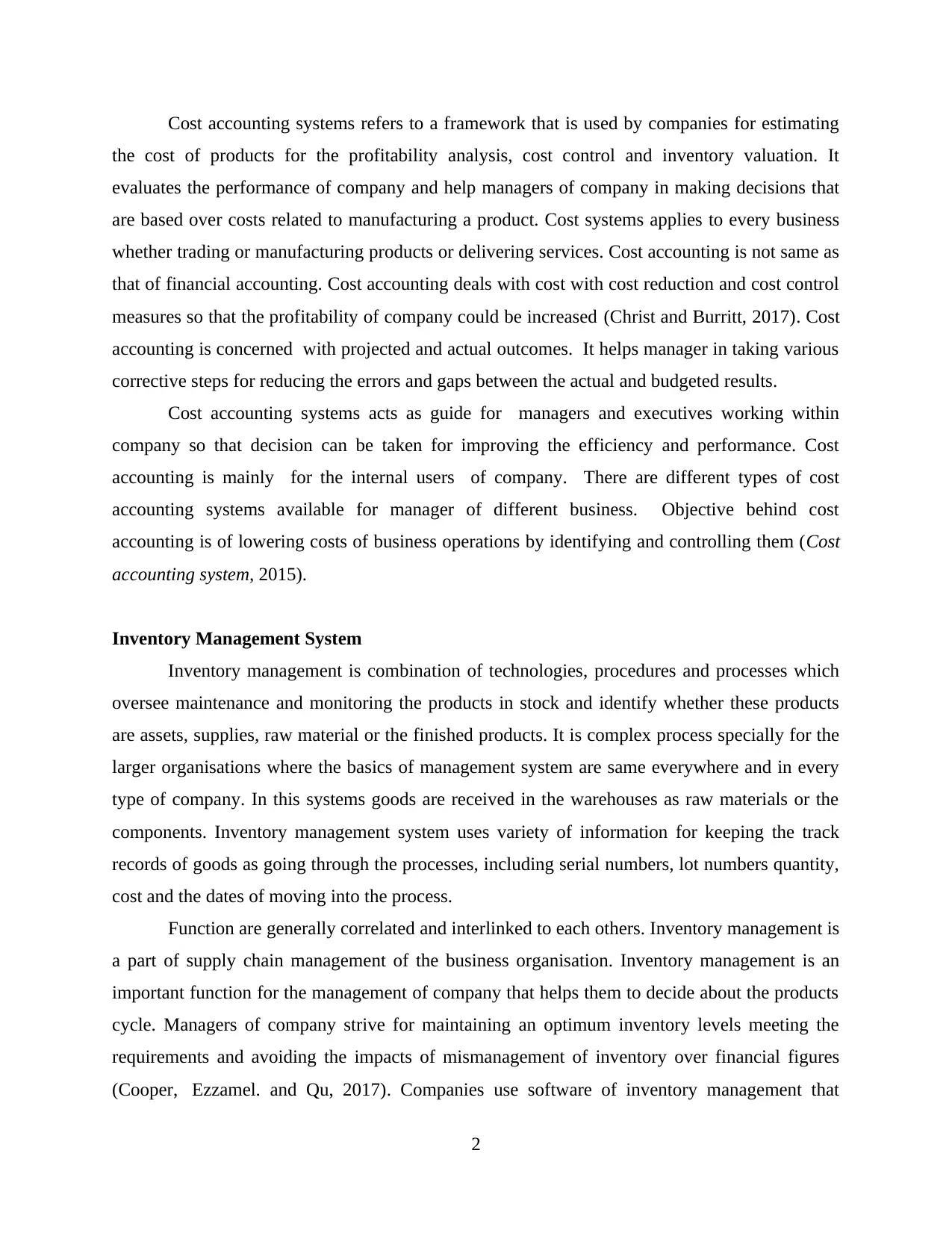
Cost accounting systems refers to a framework that is used by companies for estimating
the cost of products for the profitability analysis, cost control and inventory valuation. It
evaluates the performance of company and help managers of company in making decisions that
are based over costs related to manufacturing a product. Cost systems applies to every business
whether trading or manufacturing products or delivering services. Cost accounting is not same as
that of financial accounting. Cost accounting deals with cost with cost reduction and cost control
measures so that the profitability of company could be increased (Christ and Burritt, 2017). Cost
accounting is concerned with projected and actual outcomes. It helps manager in taking various
corrective steps for reducing the errors and gaps between the actual and budgeted results.
Cost accounting systems acts as guide for managers and executives working within
company so that decision can be taken for improving the efficiency and performance. Cost
accounting is mainly for the internal users of company. There are different types of cost
accounting systems available for manager of different business. Objective behind cost
accounting is of lowering costs of business operations by identifying and controlling them (Cost
accounting system, 2015).
Inventory Management System
Inventory management is combination of technologies, procedures and processes which
oversee maintenance and monitoring the products in stock and identify whether these products
are assets, supplies, raw material or the finished products. It is complex process specially for the
larger organisations where the basics of management system are same everywhere and in every
type of company. In this systems goods are received in the warehouses as raw materials or the
components. Inventory management system uses variety of information for keeping the track
records of goods as going through the processes, including serial numbers, lot numbers quantity,
cost and the dates of moving into the process.
Function are generally correlated and interlinked to each others. Inventory management is
a part of supply chain management of the business organisation. Inventory management is an
important function for the management of company that helps them to decide about the products
cycle. Managers of company strive for maintaining an optimum inventory levels meeting the
requirements and avoiding the impacts of mismanagement of inventory over financial figures
(Cooper, Ezzamel. and Qu, 2017). Companies use software of inventory management that
2
the cost of products for the profitability analysis, cost control and inventory valuation. It
evaluates the performance of company and help managers of company in making decisions that
are based over costs related to manufacturing a product. Cost systems applies to every business
whether trading or manufacturing products or delivering services. Cost accounting is not same as
that of financial accounting. Cost accounting deals with cost with cost reduction and cost control
measures so that the profitability of company could be increased (Christ and Burritt, 2017). Cost
accounting is concerned with projected and actual outcomes. It helps manager in taking various
corrective steps for reducing the errors and gaps between the actual and budgeted results.
Cost accounting systems acts as guide for managers and executives working within
company so that decision can be taken for improving the efficiency and performance. Cost
accounting is mainly for the internal users of company. There are different types of cost
accounting systems available for manager of different business. Objective behind cost
accounting is of lowering costs of business operations by identifying and controlling them (Cost
accounting system, 2015).
Inventory Management System
Inventory management is combination of technologies, procedures and processes which
oversee maintenance and monitoring the products in stock and identify whether these products
are assets, supplies, raw material or the finished products. It is complex process specially for the
larger organisations where the basics of management system are same everywhere and in every
type of company. In this systems goods are received in the warehouses as raw materials or the
components. Inventory management system uses variety of information for keeping the track
records of goods as going through the processes, including serial numbers, lot numbers quantity,
cost and the dates of moving into the process.
Function are generally correlated and interlinked to each others. Inventory management is
a part of supply chain management of the business organisation. Inventory management is an
important function for the management of company that helps them to decide about the products
cycle. Managers of company strive for maintaining an optimum inventory levels meeting the
requirements and avoiding the impacts of mismanagement of inventory over financial figures
(Cooper, Ezzamel. and Qu, 2017). Companies use software of inventory management that
2
Paraphrase This Document
Need a fresh take? Get an instant paraphrase of this document with our AI Paraphraser
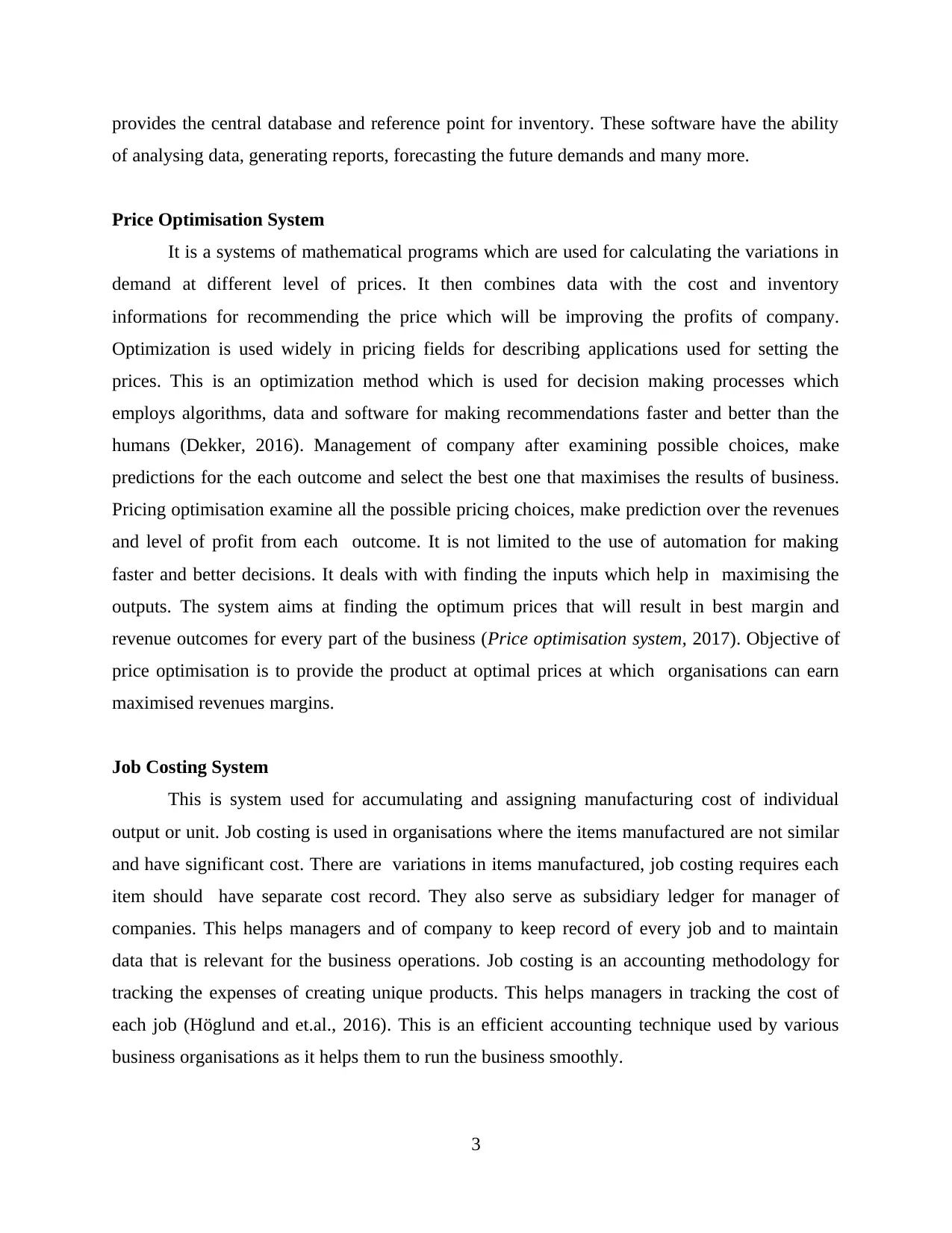
provides the central database and reference point for inventory. These software have the ability
of analysing data, generating reports, forecasting the future demands and many more.
Price Optimisation System
It is a systems of mathematical programs which are used for calculating the variations in
demand at different level of prices. It then combines data with the cost and inventory
informations for recommending the price which will be improving the profits of company.
Optimization is used widely in pricing fields for describing applications used for setting the
prices. This is an optimization method which is used for decision making processes which
employs algorithms, data and software for making recommendations faster and better than the
humans (Dekker, 2016). Management of company after examining possible choices, make
predictions for the each outcome and select the best one that maximises the results of business.
Pricing optimisation examine all the possible pricing choices, make prediction over the revenues
and level of profit from each outcome. It is not limited to the use of automation for making
faster and better decisions. It deals with with finding the inputs which help in maximising the
outputs. The system aims at finding the optimum prices that will result in best margin and
revenue outcomes for every part of the business (Price optimisation system, 2017). Objective of
price optimisation is to provide the product at optimal prices at which organisations can earn
maximised revenues margins.
Job Costing System
This is system used for accumulating and assigning manufacturing cost of individual
output or unit. Job costing is used in organisations where the items manufactured are not similar
and have significant cost. There are variations in items manufactured, job costing requires each
item should have separate cost record. They also serve as subsidiary ledger for manager of
companies. This helps managers and of company to keep record of every job and to maintain
data that is relevant for the business operations. Job costing is an accounting methodology for
tracking the expenses of creating unique products. This helps managers in tracking the cost of
each job (Höglund and et.al., 2016). This is an efficient accounting technique used by various
business organisations as it helps them to run the business smoothly.
3
of analysing data, generating reports, forecasting the future demands and many more.
Price Optimisation System
It is a systems of mathematical programs which are used for calculating the variations in
demand at different level of prices. It then combines data with the cost and inventory
informations for recommending the price which will be improving the profits of company.
Optimization is used widely in pricing fields for describing applications used for setting the
prices. This is an optimization method which is used for decision making processes which
employs algorithms, data and software for making recommendations faster and better than the
humans (Dekker, 2016). Management of company after examining possible choices, make
predictions for the each outcome and select the best one that maximises the results of business.
Pricing optimisation examine all the possible pricing choices, make prediction over the revenues
and level of profit from each outcome. It is not limited to the use of automation for making
faster and better decisions. It deals with with finding the inputs which help in maximising the
outputs. The system aims at finding the optimum prices that will result in best margin and
revenue outcomes for every part of the business (Price optimisation system, 2017). Objective of
price optimisation is to provide the product at optimal prices at which organisations can earn
maximised revenues margins.
Job Costing System
This is system used for accumulating and assigning manufacturing cost of individual
output or unit. Job costing is used in organisations where the items manufactured are not similar
and have significant cost. There are variations in items manufactured, job costing requires each
item should have separate cost record. They also serve as subsidiary ledger for manager of
companies. This helps managers and of company to keep record of every job and to maintain
data that is relevant for the business operations. Job costing is an accounting methodology for
tracking the expenses of creating unique products. This helps managers in tracking the cost of
each job (Höglund and et.al., 2016). This is an efficient accounting technique used by various
business organisations as it helps them to run the business smoothly.
3
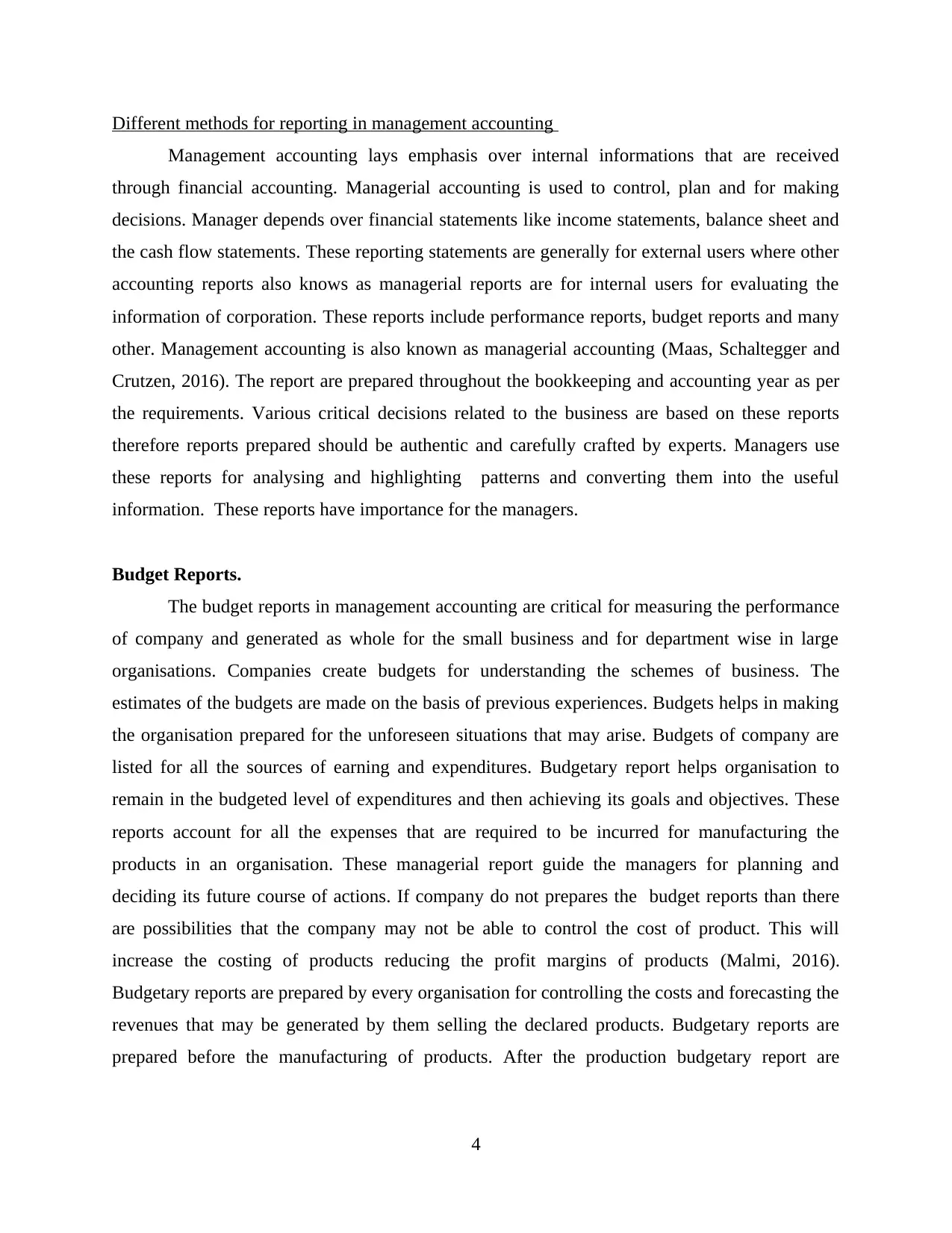
Different methods for reporting in management accounting
Management accounting lays emphasis over internal informations that are received
through financial accounting. Managerial accounting is used to control, plan and for making
decisions. Manager depends over financial statements like income statements, balance sheet and
the cash flow statements. These reporting statements are generally for external users where other
accounting reports also knows as managerial reports are for internal users for evaluating the
information of corporation. These reports include performance reports, budget reports and many
other. Management accounting is also known as managerial accounting (Maas, Schaltegger and
Crutzen, 2016). The report are prepared throughout the bookkeeping and accounting year as per
the requirements. Various critical decisions related to the business are based on these reports
therefore reports prepared should be authentic and carefully crafted by experts. Managers use
these reports for analysing and highlighting patterns and converting them into the useful
information. These reports have importance for the managers.
Budget Reports.
The budget reports in management accounting are critical for measuring the performance
of company and generated as whole for the small business and for department wise in large
organisations. Companies create budgets for understanding the schemes of business. The
estimates of the budgets are made on the basis of previous experiences. Budgets helps in making
the organisation prepared for the unforeseen situations that may arise. Budgets of company are
listed for all the sources of earning and expenditures. Budgetary report helps organisation to
remain in the budgeted level of expenditures and then achieving its goals and objectives. These
reports account for all the expenses that are required to be incurred for manufacturing the
products in an organisation. These managerial report guide the managers for planning and
deciding its future course of actions. If company do not prepares the budget reports than there
are possibilities that the company may not be able to control the cost of product. This will
increase the costing of products reducing the profit margins of products (Malmi, 2016).
Budgetary reports are prepared by every organisation for controlling the costs and forecasting the
revenues that may be generated by them selling the declared products. Budgetary reports are
prepared before the manufacturing of products. After the production budgetary report are
4
Management accounting lays emphasis over internal informations that are received
through financial accounting. Managerial accounting is used to control, plan and for making
decisions. Manager depends over financial statements like income statements, balance sheet and
the cash flow statements. These reporting statements are generally for external users where other
accounting reports also knows as managerial reports are for internal users for evaluating the
information of corporation. These reports include performance reports, budget reports and many
other. Management accounting is also known as managerial accounting (Maas, Schaltegger and
Crutzen, 2016). The report are prepared throughout the bookkeeping and accounting year as per
the requirements. Various critical decisions related to the business are based on these reports
therefore reports prepared should be authentic and carefully crafted by experts. Managers use
these reports for analysing and highlighting patterns and converting them into the useful
information. These reports have importance for the managers.
Budget Reports.
The budget reports in management accounting are critical for measuring the performance
of company and generated as whole for the small business and for department wise in large
organisations. Companies create budgets for understanding the schemes of business. The
estimates of the budgets are made on the basis of previous experiences. Budgets helps in making
the organisation prepared for the unforeseen situations that may arise. Budgets of company are
listed for all the sources of earning and expenditures. Budgetary report helps organisation to
remain in the budgeted level of expenditures and then achieving its goals and objectives. These
reports account for all the expenses that are required to be incurred for manufacturing the
products in an organisation. These managerial report guide the managers for planning and
deciding its future course of actions. If company do not prepares the budget reports than there
are possibilities that the company may not be able to control the cost of product. This will
increase the costing of products reducing the profit margins of products (Malmi, 2016).
Budgetary reports are prepared by every organisation for controlling the costs and forecasting the
revenues that may be generated by them selling the declared products. Budgetary reports are
prepared before the manufacturing of products. After the production budgetary report are
4
⊘ This is a preview!⊘
Do you want full access?
Subscribe today to unlock all pages.

Trusted by 1+ million students worldwide
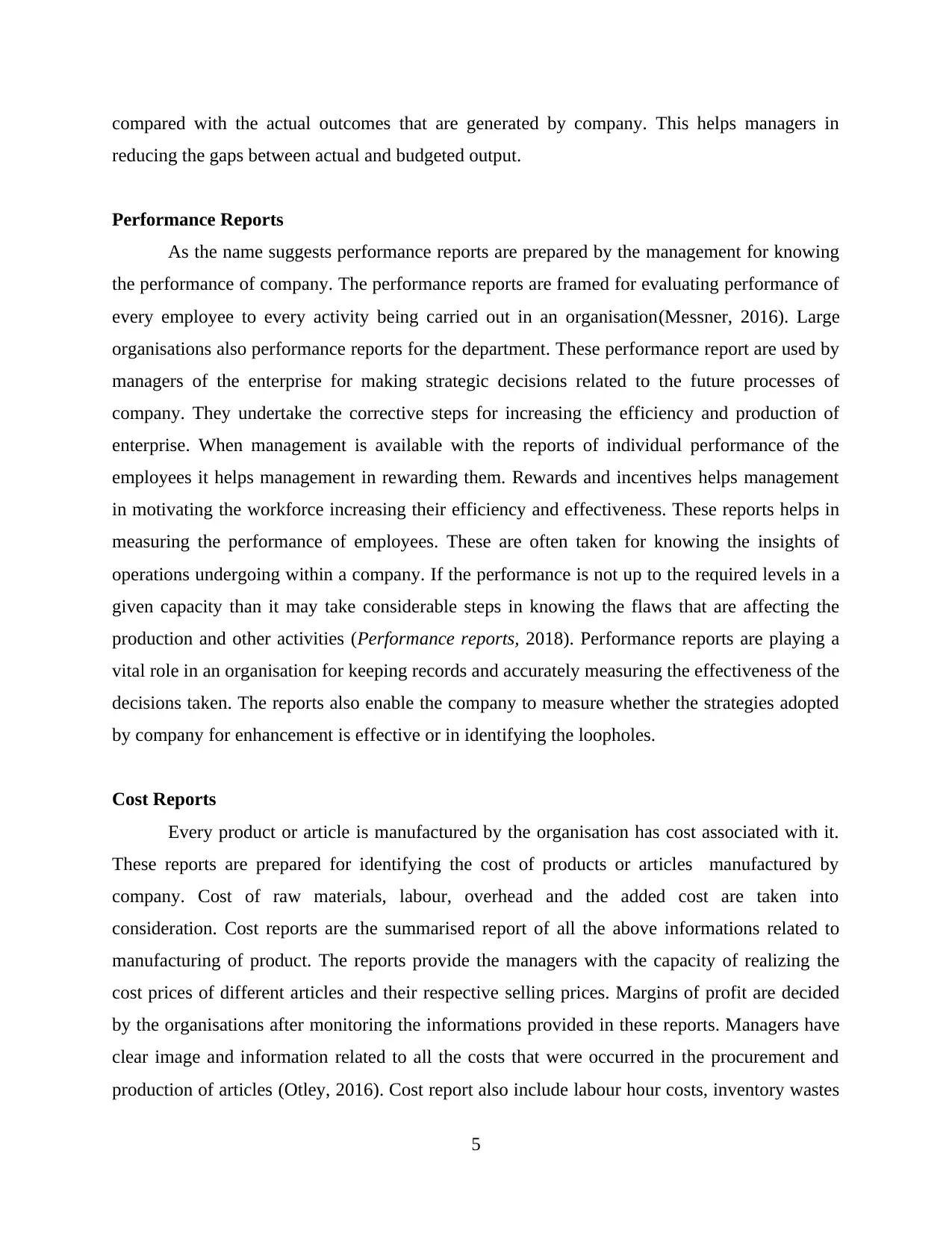
compared with the actual outcomes that are generated by company. This helps managers in
reducing the gaps between actual and budgeted output.
Performance Reports
As the name suggests performance reports are prepared by the management for knowing
the performance of company. The performance reports are framed for evaluating performance of
every employee to every activity being carried out in an organisation(Messner, 2016). Large
organisations also performance reports for the department. These performance report are used by
managers of the enterprise for making strategic decisions related to the future processes of
company. They undertake the corrective steps for increasing the efficiency and production of
enterprise. When management is available with the reports of individual performance of the
employees it helps management in rewarding them. Rewards and incentives helps management
in motivating the workforce increasing their efficiency and effectiveness. These reports helps in
measuring the performance of employees. These are often taken for knowing the insights of
operations undergoing within a company. If the performance is not up to the required levels in a
given capacity than it may take considerable steps in knowing the flaws that are affecting the
production and other activities (Performance reports, 2018). Performance reports are playing a
vital role in an organisation for keeping records and accurately measuring the effectiveness of the
decisions taken. The reports also enable the company to measure whether the strategies adopted
by company for enhancement is effective or in identifying the loopholes.
Cost Reports
Every product or article is manufactured by the organisation has cost associated with it.
These reports are prepared for identifying the cost of products or articles manufactured by
company. Cost of raw materials, labour, overhead and the added cost are taken into
consideration. Cost reports are the summarised report of all the above informations related to
manufacturing of product. The reports provide the managers with the capacity of realizing the
cost prices of different articles and their respective selling prices. Margins of profit are decided
by the organisations after monitoring the informations provided in these reports. Managers have
clear image and information related to all the costs that were occurred in the procurement and
production of articles (Otley, 2016). Cost report also include labour hour costs, inventory wastes
5
reducing the gaps between actual and budgeted output.
Performance Reports
As the name suggests performance reports are prepared by the management for knowing
the performance of company. The performance reports are framed for evaluating performance of
every employee to every activity being carried out in an organisation(Messner, 2016). Large
organisations also performance reports for the department. These performance report are used by
managers of the enterprise for making strategic decisions related to the future processes of
company. They undertake the corrective steps for increasing the efficiency and production of
enterprise. When management is available with the reports of individual performance of the
employees it helps management in rewarding them. Rewards and incentives helps management
in motivating the workforce increasing their efficiency and effectiveness. These reports helps in
measuring the performance of employees. These are often taken for knowing the insights of
operations undergoing within a company. If the performance is not up to the required levels in a
given capacity than it may take considerable steps in knowing the flaws that are affecting the
production and other activities (Performance reports, 2018). Performance reports are playing a
vital role in an organisation for keeping records and accurately measuring the effectiveness of the
decisions taken. The reports also enable the company to measure whether the strategies adopted
by company for enhancement is effective or in identifying the loopholes.
Cost Reports
Every product or article is manufactured by the organisation has cost associated with it.
These reports are prepared for identifying the cost of products or articles manufactured by
company. Cost of raw materials, labour, overhead and the added cost are taken into
consideration. Cost reports are the summarised report of all the above informations related to
manufacturing of product. The reports provide the managers with the capacity of realizing the
cost prices of different articles and their respective selling prices. Margins of profit are decided
by the organisations after monitoring the informations provided in these reports. Managers have
clear image and information related to all the costs that were occurred in the procurement and
production of articles (Otley, 2016). Cost report also include labour hour costs, inventory wastes
5
Paraphrase This Document
Need a fresh take? Get an instant paraphrase of this document with our AI Paraphraser
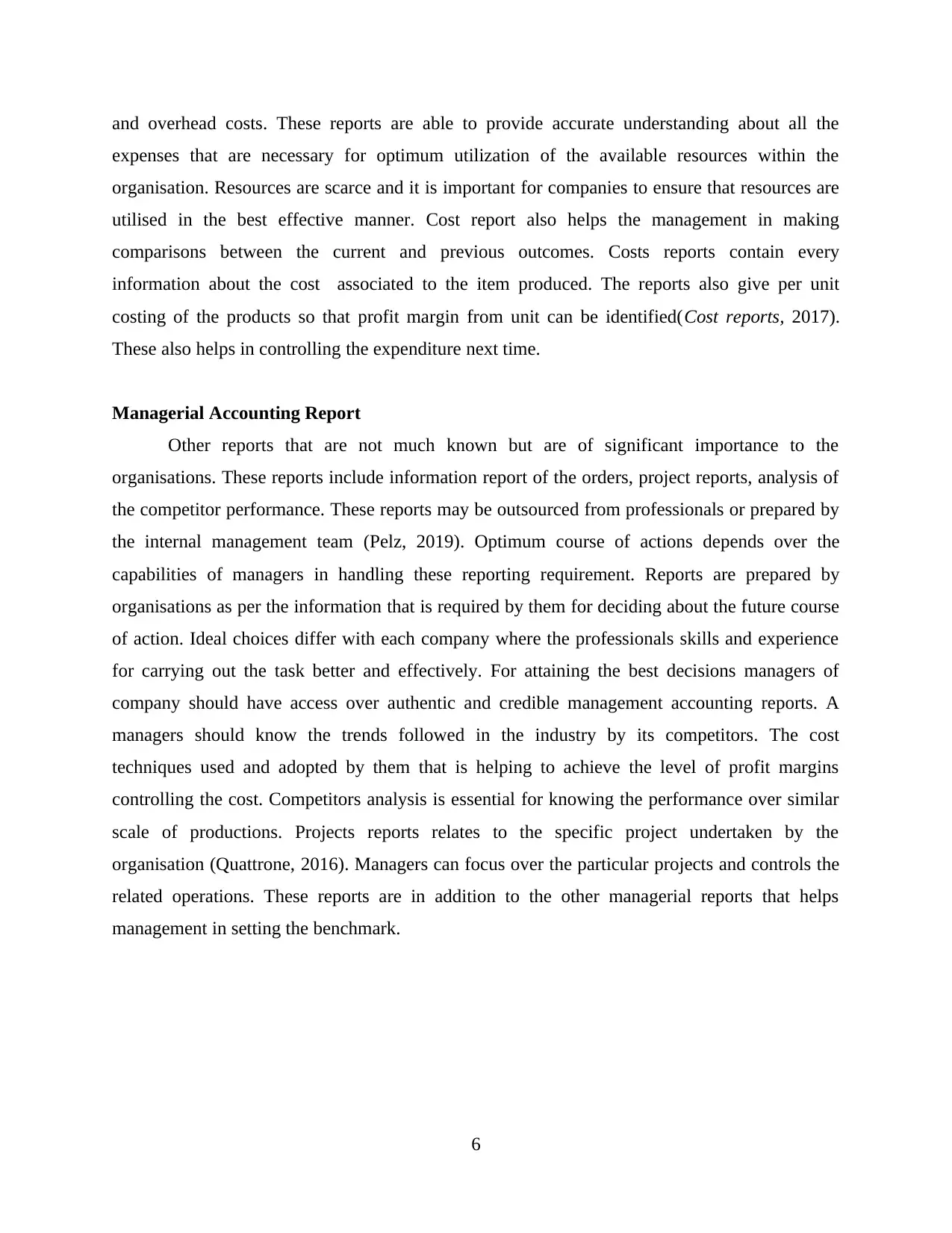
and overhead costs. These reports are able to provide accurate understanding about all the
expenses that are necessary for optimum utilization of the available resources within the
organisation. Resources are scarce and it is important for companies to ensure that resources are
utilised in the best effective manner. Cost report also helps the management in making
comparisons between the current and previous outcomes. Costs reports contain every
information about the cost associated to the item produced. The reports also give per unit
costing of the products so that profit margin from unit can be identified(Cost reports, 2017).
These also helps in controlling the expenditure next time.
Managerial Accounting Report
Other reports that are not much known but are of significant importance to the
organisations. These reports include information report of the orders, project reports, analysis of
the competitor performance. These reports may be outsourced from professionals or prepared by
the internal management team (Pelz, 2019). Optimum course of actions depends over the
capabilities of managers in handling these reporting requirement. Reports are prepared by
organisations as per the information that is required by them for deciding about the future course
of action. Ideal choices differ with each company where the professionals skills and experience
for carrying out the task better and effectively. For attaining the best decisions managers of
company should have access over authentic and credible management accounting reports. A
managers should know the trends followed in the industry by its competitors. The cost
techniques used and adopted by them that is helping to achieve the level of profit margins
controlling the cost. Competitors analysis is essential for knowing the performance over similar
scale of productions. Projects reports relates to the specific project undertaken by the
organisation (Quattrone, 2016). Managers can focus over the particular projects and controls the
related operations. These reports are in addition to the other managerial reports that helps
management in setting the benchmark.
6
expenses that are necessary for optimum utilization of the available resources within the
organisation. Resources are scarce and it is important for companies to ensure that resources are
utilised in the best effective manner. Cost report also helps the management in making
comparisons between the current and previous outcomes. Costs reports contain every
information about the cost associated to the item produced. The reports also give per unit
costing of the products so that profit margin from unit can be identified(Cost reports, 2017).
These also helps in controlling the expenditure next time.
Managerial Accounting Report
Other reports that are not much known but are of significant importance to the
organisations. These reports include information report of the orders, project reports, analysis of
the competitor performance. These reports may be outsourced from professionals or prepared by
the internal management team (Pelz, 2019). Optimum course of actions depends over the
capabilities of managers in handling these reporting requirement. Reports are prepared by
organisations as per the information that is required by them for deciding about the future course
of action. Ideal choices differ with each company where the professionals skills and experience
for carrying out the task better and effectively. For attaining the best decisions managers of
company should have access over authentic and credible management accounting reports. A
managers should know the trends followed in the industry by its competitors. The cost
techniques used and adopted by them that is helping to achieve the level of profit margins
controlling the cost. Competitors analysis is essential for knowing the performance over similar
scale of productions. Projects reports relates to the specific project undertaken by the
organisation (Quattrone, 2016). Managers can focus over the particular projects and controls the
related operations. These reports are in addition to the other managerial reports that helps
management in setting the benchmark.
6
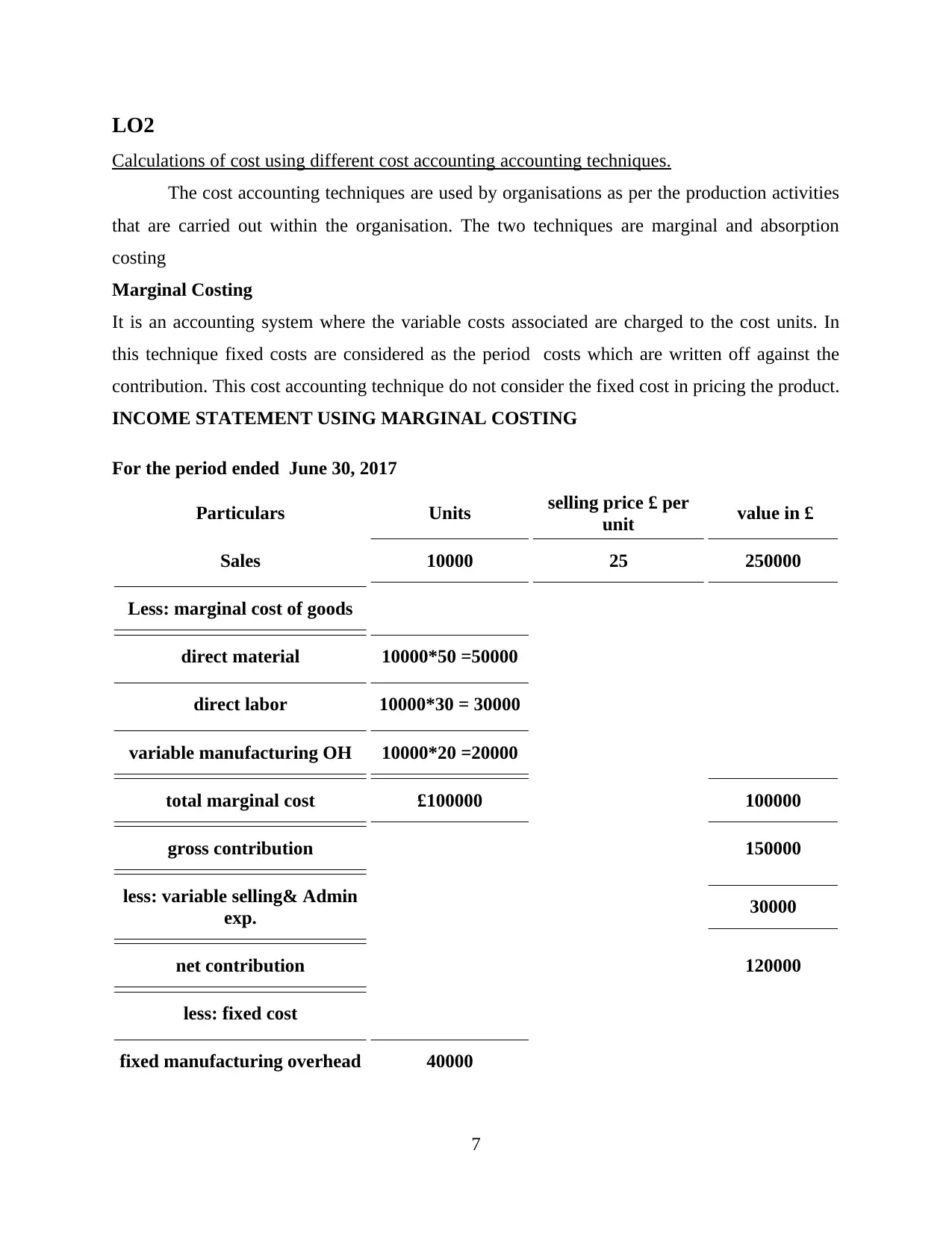
LO2
Calculations of cost using different cost accounting accounting techniques.
The cost accounting techniques are used by organisations as per the production activities
that are carried out within the organisation. The two techniques are marginal and absorption
costing
Marginal Costing
It is an accounting system where the variable costs associated are charged to the cost units. In
this technique fixed costs are considered as the period costs which are written off against the
contribution. This cost accounting technique do not consider the fixed cost in pricing the product.
INCOME STATEMENT USING MARGINAL COSTING
For the period ended June 30, 2017
Particulars Units selling price £ per
unit value in £
Sales 10000 25 250000
Less: marginal cost of goods
direct material 10000*50 =50000
direct labor 10000*30 = 30000
variable manufacturing OH 10000*20 =20000
total marginal cost £100000 100000
gross contribution 150000
less: variable selling& Admin
exp. 30000
net contribution 120000
less: fixed cost
fixed manufacturing overhead 40000
7
Calculations of cost using different cost accounting accounting techniques.
The cost accounting techniques are used by organisations as per the production activities
that are carried out within the organisation. The two techniques are marginal and absorption
costing
Marginal Costing
It is an accounting system where the variable costs associated are charged to the cost units. In
this technique fixed costs are considered as the period costs which are written off against the
contribution. This cost accounting technique do not consider the fixed cost in pricing the product.
INCOME STATEMENT USING MARGINAL COSTING
For the period ended June 30, 2017
Particulars Units selling price £ per
unit value in £
Sales 10000 25 250000
Less: marginal cost of goods
direct material 10000*50 =50000
direct labor 10000*30 = 30000
variable manufacturing OH 10000*20 =20000
total marginal cost £100000 100000
gross contribution 150000
less: variable selling& Admin
exp. 30000
net contribution 120000
less: fixed cost
fixed manufacturing overhead 40000
7
⊘ This is a preview!⊘
Do you want full access?
Subscribe today to unlock all pages.

Trusted by 1+ million students worldwide
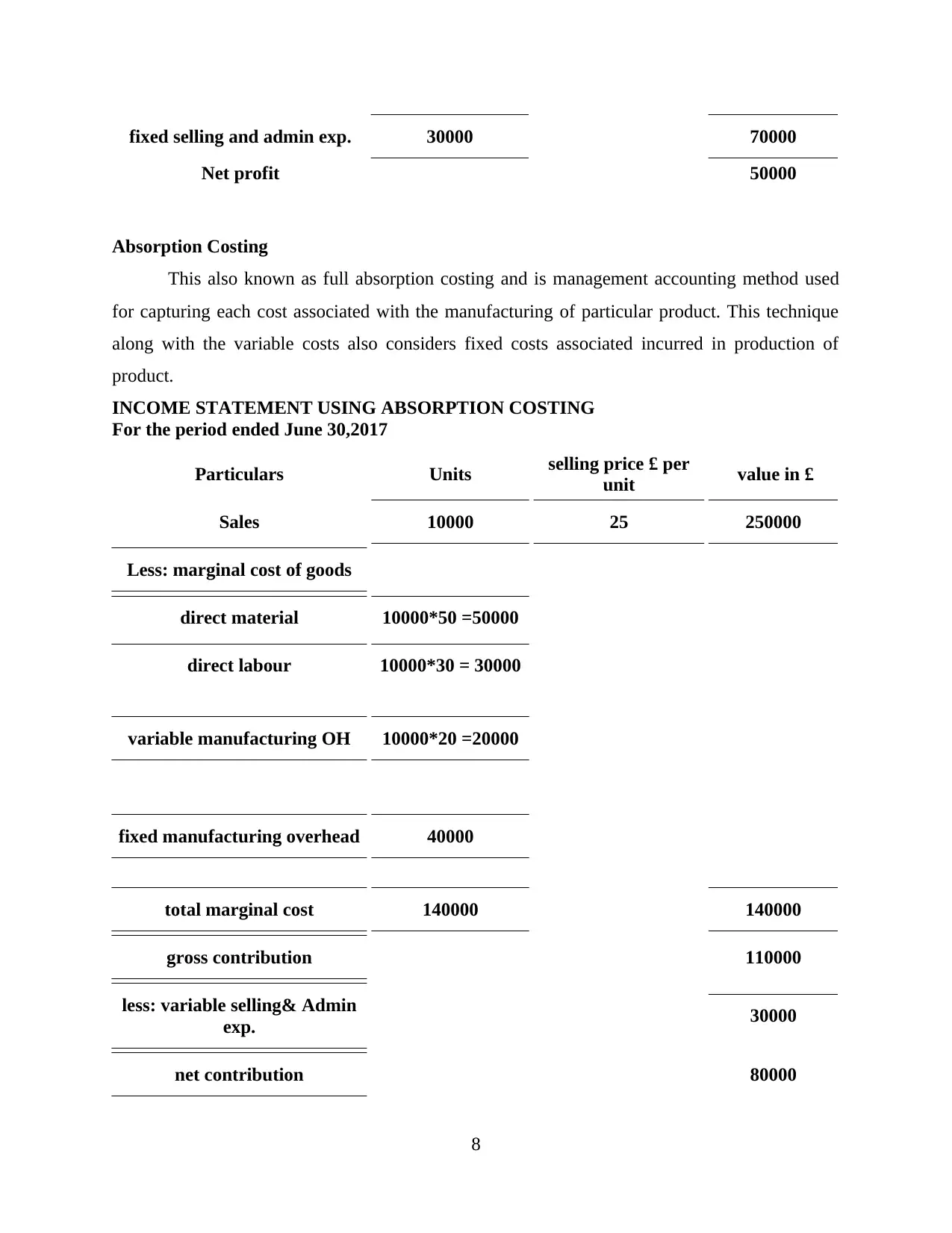
fixed selling and admin exp. 30000 70000
Net profit 50000
Absorption Costing
This also known as full absorption costing and is management accounting method used
for capturing each cost associated with the manufacturing of particular product. This technique
along with the variable costs also considers fixed costs associated incurred in production of
product.
INCOME STATEMENT USING ABSORPTION COSTING
For the period ended June 30,2017
Particulars Units selling price £ per
unit value in £
Sales 10000 25 250000
Less: marginal cost of goods
direct material 10000*50 =50000
direct labour 10000*30 = 30000
variable manufacturing OH 10000*20 =20000
fixed manufacturing overhead 40000
total marginal cost 140000 140000
gross contribution 110000
less: variable selling& Admin
exp. 30000
net contribution 80000
8
Net profit 50000
Absorption Costing
This also known as full absorption costing and is management accounting method used
for capturing each cost associated with the manufacturing of particular product. This technique
along with the variable costs also considers fixed costs associated incurred in production of
product.
INCOME STATEMENT USING ABSORPTION COSTING
For the period ended June 30,2017
Particulars Units selling price £ per
unit value in £
Sales 10000 25 250000
Less: marginal cost of goods
direct material 10000*50 =50000
direct labour 10000*30 = 30000
variable manufacturing OH 10000*20 =20000
fixed manufacturing overhead 40000
total marginal cost 140000 140000
gross contribution 110000
less: variable selling& Admin
exp. 30000
net contribution 80000
8
Paraphrase This Document
Need a fresh take? Get an instant paraphrase of this document with our AI Paraphraser
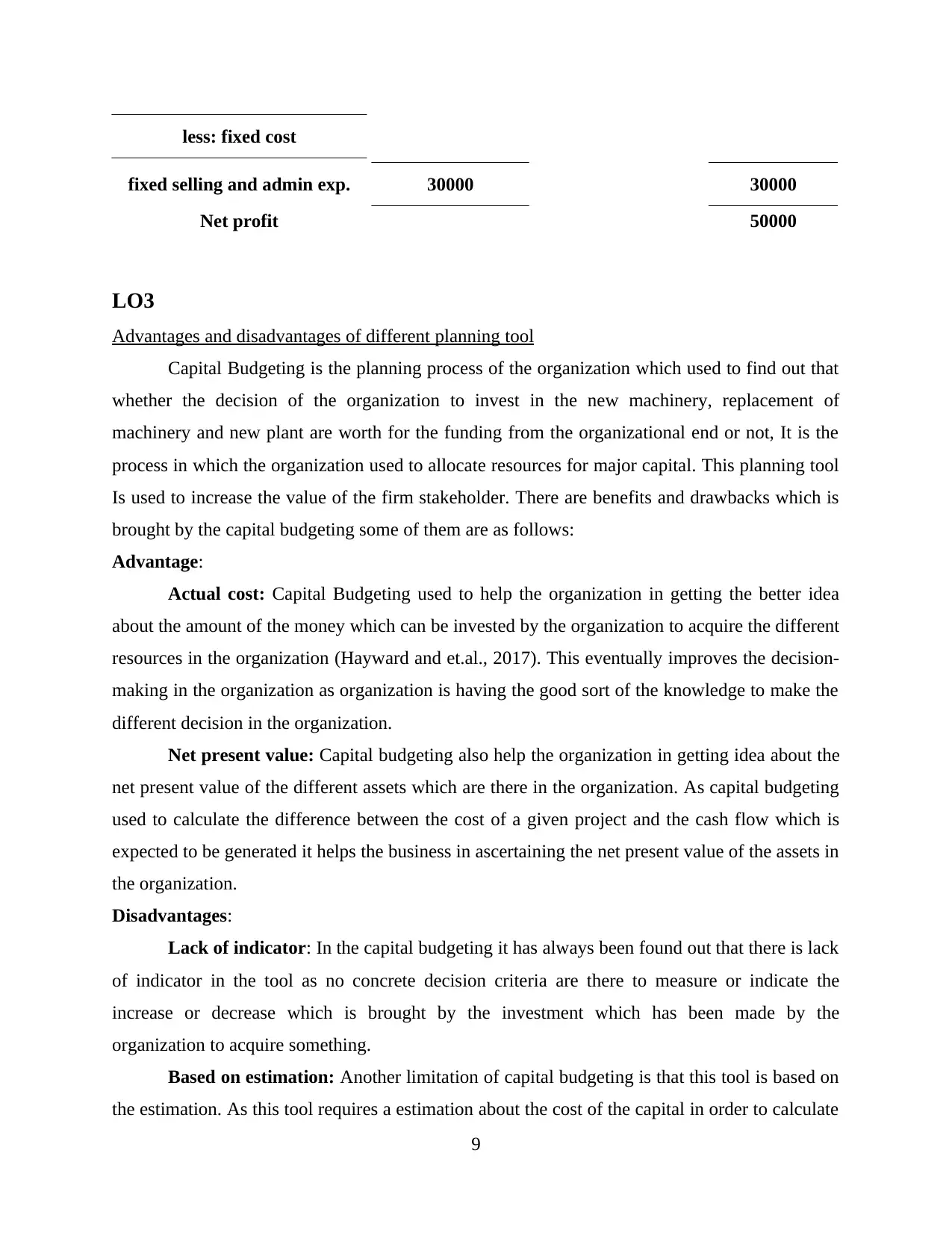
less: fixed cost
fixed selling and admin exp. 30000 30000
Net profit 50000
LO3
Advantages and disadvantages of different planning tool
Capital Budgeting is the planning process of the organization which used to find out that
whether the decision of the organization to invest in the new machinery, replacement of
machinery and new plant are worth for the funding from the organizational end or not, It is the
process in which the organization used to allocate resources for major capital. This planning tool
Is used to increase the value of the firm stakeholder. There are benefits and drawbacks which is
brought by the capital budgeting some of them are as follows:
Advantage:
Actual cost: Capital Budgeting used to help the organization in getting the better idea
about the amount of the money which can be invested by the organization to acquire the different
resources in the organization (Hayward and et.al., 2017). This eventually improves the decision-
making in the organization as organization is having the good sort of the knowledge to make the
different decision in the organization.
Net present value: Capital budgeting also help the organization in getting idea about the
net present value of the different assets which are there in the organization. As capital budgeting
used to calculate the difference between the cost of a given project and the cash flow which is
expected to be generated it helps the business in ascertaining the net present value of the assets in
the organization.
Disadvantages:
Lack of indicator: In the capital budgeting it has always been found out that there is lack
of indicator in the tool as no concrete decision criteria are there to measure or indicate the
increase or decrease which is brought by the investment which has been made by the
organization to acquire something.
Based on estimation: Another limitation of capital budgeting is that this tool is based on
the estimation. As this tool requires a estimation about the cost of the capital in order to calculate
9
fixed selling and admin exp. 30000 30000
Net profit 50000
LO3
Advantages and disadvantages of different planning tool
Capital Budgeting is the planning process of the organization which used to find out that
whether the decision of the organization to invest in the new machinery, replacement of
machinery and new plant are worth for the funding from the organizational end or not, It is the
process in which the organization used to allocate resources for major capital. This planning tool
Is used to increase the value of the firm stakeholder. There are benefits and drawbacks which is
brought by the capital budgeting some of them are as follows:
Advantage:
Actual cost: Capital Budgeting used to help the organization in getting the better idea
about the amount of the money which can be invested by the organization to acquire the different
resources in the organization (Hayward and et.al., 2017). This eventually improves the decision-
making in the organization as organization is having the good sort of the knowledge to make the
different decision in the organization.
Net present value: Capital budgeting also help the organization in getting idea about the
net present value of the different assets which are there in the organization. As capital budgeting
used to calculate the difference between the cost of a given project and the cash flow which is
expected to be generated it helps the business in ascertaining the net present value of the assets in
the organization.
Disadvantages:
Lack of indicator: In the capital budgeting it has always been found out that there is lack
of indicator in the tool as no concrete decision criteria are there to measure or indicate the
increase or decrease which is brought by the investment which has been made by the
organization to acquire something.
Based on estimation: Another limitation of capital budgeting is that this tool is based on
the estimation. As this tool requires a estimation about the cost of the capital in order to calculate
9
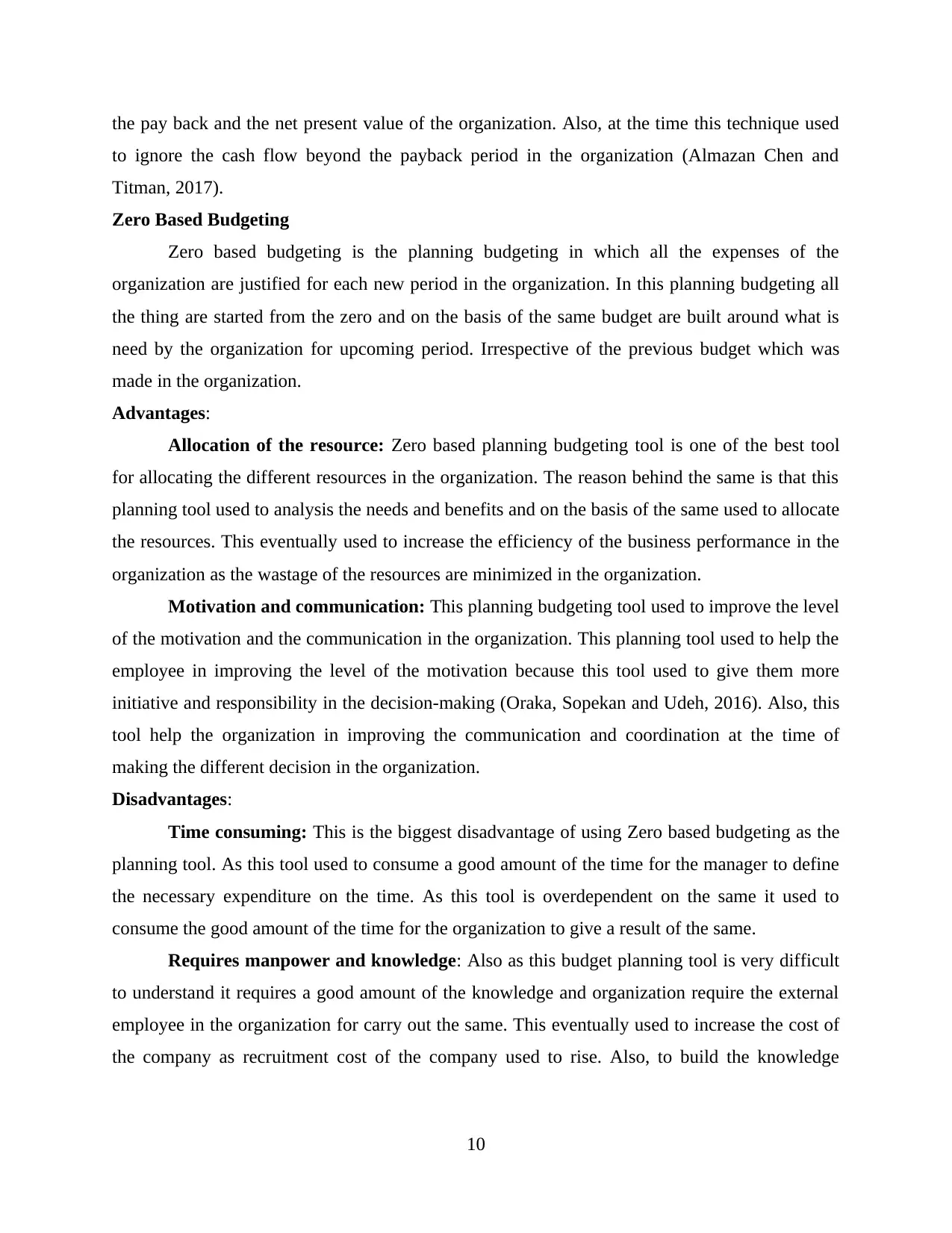
the pay back and the net present value of the organization. Also, at the time this technique used
to ignore the cash flow beyond the payback period in the organization (Almazan Chen and
Titman, 2017).
Zero Based Budgeting
Zero based budgeting is the planning budgeting in which all the expenses of the
organization are justified for each new period in the organization. In this planning budgeting all
the thing are started from the zero and on the basis of the same budget are built around what is
need by the organization for upcoming period. Irrespective of the previous budget which was
made in the organization.
Advantages:
Allocation of the resource: Zero based planning budgeting tool is one of the best tool
for allocating the different resources in the organization. The reason behind the same is that this
planning tool used to analysis the needs and benefits and on the basis of the same used to allocate
the resources. This eventually used to increase the efficiency of the business performance in the
organization as the wastage of the resources are minimized in the organization.
Motivation and communication: This planning budgeting tool used to improve the level
of the motivation and the communication in the organization. This planning tool used to help the
employee in improving the level of the motivation because this tool used to give them more
initiative and responsibility in the decision-making (Oraka, Sopekan and Udeh, 2016). Also, this
tool help the organization in improving the communication and coordination at the time of
making the different decision in the organization.
Disadvantages:
Time consuming: This is the biggest disadvantage of using Zero based budgeting as the
planning tool. As this tool used to consume a good amount of the time for the manager to define
the necessary expenditure on the time. As this tool is overdependent on the same it used to
consume the good amount of the time for the organization to give a result of the same.
Requires manpower and knowledge: Also as this budget planning tool is very difficult
to understand it requires a good amount of the knowledge and organization require the external
employee in the organization for carry out the same. This eventually used to increase the cost of
the company as recruitment cost of the company used to rise. Also, to build the knowledge
10
to ignore the cash flow beyond the payback period in the organization (Almazan Chen and
Titman, 2017).
Zero Based Budgeting
Zero based budgeting is the planning budgeting in which all the expenses of the
organization are justified for each new period in the organization. In this planning budgeting all
the thing are started from the zero and on the basis of the same budget are built around what is
need by the organization for upcoming period. Irrespective of the previous budget which was
made in the organization.
Advantages:
Allocation of the resource: Zero based planning budgeting tool is one of the best tool
for allocating the different resources in the organization. The reason behind the same is that this
planning tool used to analysis the needs and benefits and on the basis of the same used to allocate
the resources. This eventually used to increase the efficiency of the business performance in the
organization as the wastage of the resources are minimized in the organization.
Motivation and communication: This planning budgeting tool used to improve the level
of the motivation and the communication in the organization. This planning tool used to help the
employee in improving the level of the motivation because this tool used to give them more
initiative and responsibility in the decision-making (Oraka, Sopekan and Udeh, 2016). Also, this
tool help the organization in improving the communication and coordination at the time of
making the different decision in the organization.
Disadvantages:
Time consuming: This is the biggest disadvantage of using Zero based budgeting as the
planning tool. As this tool used to consume a good amount of the time for the manager to define
the necessary expenditure on the time. As this tool is overdependent on the same it used to
consume the good amount of the time for the organization to give a result of the same.
Requires manpower and knowledge: Also as this budget planning tool is very difficult
to understand it requires a good amount of the knowledge and organization require the external
employee in the organization for carry out the same. This eventually used to increase the cost of
the company as recruitment cost of the company used to rise. Also, to build the knowledge
10
⊘ This is a preview!⊘
Do you want full access?
Subscribe today to unlock all pages.

Trusted by 1+ million students worldwide
1 out of 21
Related Documents
Your All-in-One AI-Powered Toolkit for Academic Success.
+13062052269
info@desklib.com
Available 24*7 on WhatsApp / Email
![[object Object]](/_next/static/media/star-bottom.7253800d.svg)
Unlock your academic potential
Copyright © 2020–2025 A2Z Services. All Rights Reserved. Developed and managed by ZUCOL.





